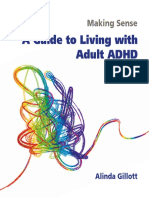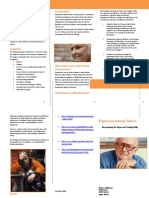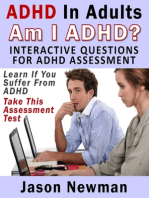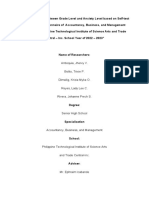ISPN-Poster Presentation
ISPN-Poster Presentation
Uploaded by
Deepak Krishnamurthy KCopyright:
Available Formats
ISPN-Poster Presentation
ISPN-Poster Presentation
Uploaded by
Deepak Krishnamurthy KOriginal Title
Copyright
Available Formats
Share this document
Did you find this document useful?
Is this content inappropriate?
Copyright:
Available Formats
ISPN-Poster Presentation
ISPN-Poster Presentation
Uploaded by
Deepak Krishnamurthy KCopyright:
Available Formats
A CROSS SECTIONAL STUDY TO ASSESS THE LEVEL OF DEPRESSION AMONG ELDERLY
PEOPLE LIVING IN OLD AGE HOME IN ANAND-KHEDA DISTRICTS, GUJARAT
Ms. PriyankaHathila*, Ms. Angelina Makwana* ,Ms. Krishna Patadia*, Ms.Damini Patel*, Ms.Heena Patel*, Ms. Pooja Patel*, Ms. NashirunSamli* Deepak K**,
*Students of MTIN , ** Assistant Professor
Introduction Methods Results con’t LIMITATIONS
A descriptive research design was adopted to assess the level of depression among
Elderly people are like children with their mood swings, sometimes too elderly people living in old age homes. •Study was limited to elderly people who are living in old age homes in Anand-
quickly not allowing as enough time to grasp. Elders need attention at 30 point Geriatric Depression scale was used to collect data from elderly people who
Table 2.1: Shows that 17(42.5%) of elderly people had no depression, 20(50%) of elderly
Kheda districts Gujarat.
people had mild depression, 3 (7.5%) had severe depression
homes and if we do not give it, they start demanding it. When the elders are living in old age homes in Anand-Kheda districts, Gujarat. •Elderly person who belong to age group 60 or more than 60 years of age.
begin to feel they are neglected, they adopt ways to attract attention from The resulting score was interpreted as follows: score 0-9 suggests no depression, score •Available during the period of study.
us. They need vital support that will keep important aspects of their life- 10-19 suggests mild depression and 20-30 suggests severe depression.
•Willing to participate in the study
styles intact while identify and in turn it leads to low morale, decreased Level of depression No of respondents Percentage •Able to understand the concept in English or Gujarati language
level of satisfaction, depression and feeling of loneliness and frequency
helplessness.[1][2] Results
Geriatric depression is seen in elderly people whose age is 60 years or
No depression
(0-9)
17 42.5 RECOMMENDATION
above 60 years. Geriatric depression is a major health with divesting
outcomes. Depression in elderly may create many health problems in Graph1: Percentage distribution of elderly people according to their age. Mild depression 20 50
carrying out activities of daily living. Old age homes are a need of today as Based on the findings of the study the following recommendations are
(10-19)
the life style changes fast and diminish acceptance of family made:
responsibilities towards one’s elder. [2] Severe depression 3 7.5 A similar study may be conducted on a larger sample for wider
India is one of the South East Asian countries, in India by the year 2001 (20-30) generalization.
there were around 76 million elderly people, who constituted 7.7% of the A similar descriptive study may be conducted in other areas.
country’s population .Currently there is 9.8 percent elderly people in the A similar study can be undertaken in different settings.
country. It is expected to increase further to fourteen percent by 2025. [3] A comparative study can be undertaken.
Discussion
Graph 4:Percentage distribution of elderly people according to level of depression
Purpose
50
50 42.5 The findings of the study revealed that 17(42.5%) of elderly people had no
40 depression, 20(50%) of elderly people had mild depression, 3 (7.5%) had
Depression is the most common disturbance of mood experienced by elderly. It is a
PERCENTAGE
Graph 2: Percentage distribution of elderly people according to their gender. severe depression. Here, the researcher can encourage elderly people for
pathological mood disturbance characterized by feelings, attitudes and beliefs the 30
person has about self and his environment, such as pessimism, Hopelessness
doing different activities for elderly people so they can deviate their mind
20
Helplessness, low self-esteem and a guilt feeling. 7.5
in different activity. The nurse researcher can give different therapy such as
10 Yoga therapy, meditation, Exercise, so they can divert their mind which
Depression will increase in magnitude as the elderly population increase year by year. 0 helps for decrease the level of depression among elderly people living in
Hence there is need for considering the emotional states of elderly when they treated No depression Mild depression Severe depression
(0-9) (10-19) (20-30)
old age homes.
for any of physical problem in the hospitals, homes, or in primary health centres. This
motivated the investigator to conduct the study to assess the level of depression LEVEL OF DEPRESSION
among the elderly who are residing in the old age home with different types of
alignment. Conclusions
OBJECTIVES
1. To assess the level of depression among elderly people living in old age homes. Table 2.2: shows that Association between level of depression among elderly The present study aimed at assessing the level of depression among elderly
2. To associate the level of depression among elderly people living in old age home people living in old age homes people living in old age homes in Anand-Kheda Districts of Gujarat. 30 point
with their selected demographical variables. Geriatric Depression Scale was used to assess the level of depression among
Variable Sample Total score Chi elderly people by using convenient sampling technique. Data was collected by
using interview method. The study revealed that the 42.5% of elderly people
Square
Sample
Graph 3: Percentage distribution of elderly people according to their activities No % ≤Median > Median had no depression, 50% of elderly people had mild Depression, 7.5% had
value severe depression.
No 21 % No 19 %
Samples: Elderly people living in old age homes whose age is 60 or more than 60
years 80
72.5
Activities
References
Sample Size: 40 elderly people 70
Sampling Technique : Convenient Sampling Technique 60 a)Personal 12 30% 2 9.52% 10 52.63% 12.81 1. LouiseRebracaShives. Basic Concepts of psychiatric-mental Health Nursing
Inclusive criteria: Elderly people who are willing to participate and who can read
PERCENTAGE
50 7thEdition, 2008,p 529
or write Gujarati. 40 2. Karensaucer, Sharyn Janes,K.s.Lundy.Essentials of community based nursing, 1st
Exclusive Criteria: Elderly people who do not want to participate and also who 17.5 b)Spiritual 22 55% 16 76.19% 6 31.57% df=3
30 edition. Canada: Jones and Barlett publishers; 2003.p502, 504,509,525.
have chronic illness. 20
10
3. Gulani K K. Community health nursing principles and practices, 1stedition, New
0
10 Delhi: Kumar Publishing House; 2005, p.469-471.
c) Yoga & 2 5% 2 9.52% 0 0% S
0 4. Park K. Text book of preventive and social medicine. 18thedition, Jabalpur, India:
Individual Spirituality Yoga and Gardening exercise Banarasidas Bhanot Publication.2007 p.382.
exercise 5. Bimla Kapoor. Text book of psychiatric nursing. 1st edition, New Delhi:
d)Gardening 4 10% 1 4.76% 3 15.78% Kumarpublishing house; 2005, p272-275.
ACTIVITES
6. Polit & Hungler, Nursing research principles and methods, 5thedition,Philadalphia
:Lippincott company .1999.p69-70.
You might also like
- Therapeutic CommunicationDocument5 pagesTherapeutic CommunicationDishu100% (7)
- Making Sense of Adult ADHD BookletDocument20 pagesMaking Sense of Adult ADHD BookletAryn Phillips100% (1)
- BrochureDocument2 pagesBrochureBahaa_Stephano_6090No ratings yet
- Kualitas Hidup Pada Lansia Dengan Gangguan Kognitif Dan Mental: Studi Cross Sectional Di Kelurahan Kalianyar, Jakarta BaratDocument11 pagesKualitas Hidup Pada Lansia Dengan Gangguan Kognitif Dan Mental: Studi Cross Sectional Di Kelurahan Kalianyar, Jakarta BaratBhe Che Link-linkNo ratings yet
- Clinical Practice Guidelines For Management of Depression in ElderlyDocument22 pagesClinical Practice Guidelines For Management of Depression in ElderlyAmalina Elvira AnggrainiNo ratings yet
- Disintegrative Syndrome in Young Adults PDFDocument1 pageDisintegrative Syndrome in Young Adults PDFLorelay HernanNo ratings yet
- Effectiveness of Reminiscence Therapy and Brain GyDocument11 pagesEffectiveness of Reminiscence Therapy and Brain Gy20161293No ratings yet
- Pengaruh Faktor-Faktor Psikososial Dan Insomnia Terhadap Depresi Pada Lansia Di Kota YogyakartaDocument5 pagesPengaruh Faktor-Faktor Psikososial Dan Insomnia Terhadap Depresi Pada Lansia Di Kota YogyakartaKristina Puji LestariNo ratings yet
- A Study To Assess The Depression and QOL Among Elderly People Residing Old Age Home, KaraikalDocument1 pageA Study To Assess The Depression and QOL Among Elderly People Residing Old Age Home, Karaikalgao1989No ratings yet
- Nur Rakhmanto HeryanaDocument8 pagesNur Rakhmanto Heryana2117 Sentia SitungkirNo ratings yet
- 702-Article Text-1221-1-10-20191210Document10 pages702-Article Text-1221-1-10-20191210Dwi Cantika LuthfiahNo ratings yet
- 566 1877 1 PBDocument9 pages566 1877 1 PBIndri Niza AnastasyahNo ratings yet
- Friedlander Depression 2001Document10 pagesFriedlander Depression 2001Carol LlanosNo ratings yet
- DEM - EN - Final - June 2017Document2 pagesDEM - EN - Final - June 2017Sameer DayaNo ratings yet
- DepressionDocument31 pagesDepressionliviakillstein12No ratings yet
- Oral PresentDocument8 pagesOral PresentWimar AnugrahNo ratings yet
- Mood DisordersDocument9 pagesMood DisordersEeswari Chandra SegarNo ratings yet
- Depressive DisordersDocument9 pagesDepressive Disorderslengkong100% (1)
- Old Age Project - DepressionDocument16 pagesOld Age Project - Depressionayla josephNo ratings yet
- Influence of Reminiscence Group Therapy Toward Depression Scores in Elderly in The Age of Service and Administration (BPPLU) in Bengkulu ProvinceDocument6 pagesInfluence of Reminiscence Group Therapy Toward Depression Scores in Elderly in The Age of Service and Administration (BPPLU) in Bengkulu ProvinceAnonymous izrFWiQ100% (1)
- Depression and Determinant Factors Among Elderly IDocument3 pagesDepression and Determinant Factors Among Elderly IDHASARATHI kUMARNo ratings yet
- Mood Disorders in Primary Health Care Dr. Carasig 1Document2 pagesMood Disorders in Primary Health Care Dr. Carasig 1manideepreddyNo ratings yet
- Depression Parents Medication GuideDocument20 pagesDepression Parents Medication GuideThaís PireddaNo ratings yet
- Depression in India Let S Talk 1Document50 pagesDepression in India Let S Talk 1shilpaNo ratings yet
- Dysthymia BiruDocument39 pagesDysthymia Biruhilmi sallehNo ratings yet
- Assignment Cover Sheet: Student DetailsDocument12 pagesAssignment Cover Sheet: Student DetailsQuang minh nguyenNo ratings yet
- A Comparative Study To Assess The Level of Depression Among The Elderly Living in Old Age Homes and Community, PuducherryDocument7 pagesA Comparative Study To Assess The Level of Depression Among The Elderly Living in Old Age Homes and Community, PuducherryIJAR JOURNALNo ratings yet
- Hub Lma Tinggal DGN Tingkat Depresi Pada Lanjut UsiaDocument6 pagesHub Lma Tinggal DGN Tingkat Depresi Pada Lanjut UsiaKurnia HandayaniNo ratings yet
- Cognitive Impairment, Dementia, and Occupational Therapy InterventionsDocument21 pagesCognitive Impairment, Dementia, and Occupational Therapy Interventionsvandrade_635870No ratings yet
- Geriatric Depression and Its Relation With Cognitive Impairment and DementiaDocument7 pagesGeriatric Depression and Its Relation With Cognitive Impairment and DementiajcurazanNo ratings yet
- Subjective Cognitive Decline 508Document9 pagesSubjective Cognitive Decline 508Samara NogueiraNo ratings yet
- Borderline Personality Disorder 2018Document1 pageBorderline Personality Disorder 2018Nata Papanatas100% (2)
- Dementia Ppt Biopsych Project (1)Document22 pagesDementia Ppt Biopsych Project (1)Mehma KaurNo ratings yet
- 1. Psychy Crash Course Supplement 2022Document20 pages1. Psychy Crash Course Supplement 2022Mukesh SahooNo ratings yet
- Characteri Stics MDD Dysthymic DisorderDocument2 pagesCharacteri Stics MDD Dysthymic Disorderhilmi sallehNo ratings yet
- Study On Depression Among Elderly People in An UrbDocument5 pagesStudy On Depression Among Elderly People in An UrbKarimul IslamNo ratings yet
- BrochureDocument1 pageBrochureJoshuaBredehoeftNo ratings yet
- Brochure About Mental HealthDocument2 pagesBrochure About Mental HealthAron PholleNo ratings yet
- Yeshvanth DepressionDocument22 pagesYeshvanth DepressionVishwa KNo ratings yet
- Depression: Answers To Students' Frequently Asked Questions About DepressionDocument4 pagesDepression: Answers To Students' Frequently Asked Questions About DepressionRalphNo ratings yet
- Chapter 5. Mood DisordersDocument22 pagesChapter 5. Mood DisordersmariacarloschiclanaNo ratings yet
- Orygen Depression Yp FactsheetDocument2 pagesOrygen Depression Yp FactsheetWestwickateNo ratings yet
- 7042 33216 1 PBDocument21 pages7042 33216 1 PBHurinNo ratings yet
- A Study To Effect of Reminiscence Therapy On Psychological Well-Being Among Elderly Residing in Selected Old Age HomeDocument5 pagesA Study To Effect of Reminiscence Therapy On Psychological Well-Being Among Elderly Residing in Selected Old Age HomeInternational Journal of Innovative Science and Research TechnologyNo ratings yet
- DepressionDocument2 pagesDepressionIQRA ZAINABNo ratings yet
- Depression Supporting Students at School PDFDocument3 pagesDepression Supporting Students at School PDFMrié ChrsNo ratings yet
- Doc-20240131-Wa0 240131 223836Document5 pagesDoc-20240131-Wa0 240131 22383622alhumidi2020No ratings yet
- Iand Poster - FinalDocument1 pageIand Poster - Finalapi-456164848No ratings yet
- Depressive Disorders Bipolar Disorder SuicideDocument13 pagesDepressive Disorders Bipolar Disorder Suicidenaji santiagoNo ratings yet
- Keyword: Elderly, Depression, Reminiscence Group StartegyDocument7 pagesKeyword: Elderly, Depression, Reminiscence Group StartegysonNo ratings yet
- Adult Adhd EducationDocument9 pagesAdult Adhd EducationIsabela BragaNo ratings yet
- Depressive DisorderDocument59 pagesDepressive DisorderJoshua RingorNo ratings yet
- W6 - Depressive and Bipolar DisordersDocument40 pagesW6 - Depressive and Bipolar DisorderspsksenakayaNo ratings yet
- Food: Food: Food: Food: Food:: Mood Mood Mood Mood MoodDocument4 pagesFood: Food: Food: Food: Food:: Mood Mood Mood Mood Moodcklcat1437No ratings yet
- Depression FactSheet PowerpointDocument18 pagesDepression FactSheet PowerpointcelestinoptrixieNo ratings yet
- Wang2012 (Recovered) (Recovered)Document6 pagesWang2012 (Recovered) (Recovered)Miranti Dea DoraNo ratings yet
- Mindfulness Training For Adults With Attention-Deficit:Hyperactivity Disorder - Implementation of Mindful Awareness Practices in A French-Speaking Attention-Deficit: Hyperactivity Disorder UnitDocument5 pagesMindfulness Training For Adults With Attention-Deficit:Hyperactivity Disorder - Implementation of Mindful Awareness Practices in A French-Speaking Attention-Deficit: Hyperactivity Disorder UnitIsabela NerysNo ratings yet
- Mental Health AwarenessDocument3 pagesMental Health Awarenessnor ahlina muhd rodhiNo ratings yet
- Persistent Depressive DisorderDocument15 pagesPersistent Depressive Disordercoolgirl4realzNo ratings yet
- Depression ADAA Brochure 2016Document13 pagesDepression ADAA Brochure 2016GiuliaGiuliNo ratings yet
- ADHD In Adults: Am I ADHD? Interactive Questions For ADHD Assessment: Learn If You Suffer From ADHD - Take This Assessment TestFrom EverandADHD In Adults: Am I ADHD? Interactive Questions For ADHD Assessment: Learn If You Suffer From ADHD - Take This Assessment TestNo ratings yet
- Kami Export - The Remarkable Reach of Growth Mind Discussion QuestionsDocument3 pagesKami Export - The Remarkable Reach of Growth Mind Discussion Questions23settipanemoorec Settipane-MooreNo ratings yet
- Case Study Answers: Noon Business SchoolDocument6 pagesCase Study Answers: Noon Business SchoolMuhammad Arslan AkramNo ratings yet
- Tobacco Cessation Clinic TemplateDocument1 pageTobacco Cessation Clinic Templatesavvy_as_98No ratings yet
- The Relationship Between Grade Level and Anxiety Level Based On Self-Test For Anxiety Questionnaire of Accountancy, Business, and Management StudentsDocument16 pagesThe Relationship Between Grade Level and Anxiety Level Based On Self-Test For Anxiety Questionnaire of Accountancy, Business, and Management StudentsLady Lee ReyesNo ratings yet
- Speaking Part1,2,3,4Document3 pagesSpeaking Part1,2,3,4Aina PunteroNo ratings yet
- Marketing BrochureDocument1 pageMarketing BrochureSteven TanNo ratings yet
- Myra Estrin Levine: Ii. Philosophical Underpinnings of TheoryDocument3 pagesMyra Estrin Levine: Ii. Philosophical Underpinnings of TheoryKate DabucolNo ratings yet
- Research Proposal GagDocument6 pagesResearch Proposal Gaggwynethguarino143No ratings yet
- 190.full - Narrative ResearchDocument7 pages190.full - Narrative ResearchKHALIL UR REHMANNo ratings yet
- Nora Ephron EssaysDocument8 pagesNora Ephron Essaysxlgnhkaeg100% (2)
- 14 Unique and Effective Ways To Get Out of ADHD ParalysisDocument57 pages14 Unique and Effective Ways To Get Out of ADHD Paralysiscvbkmwv59eNo ratings yet
- MCQ Self Management Skills MCQDocument7 pagesMCQ Self Management Skills MCQSohshriNo ratings yet
- Onlinestatbook CasesDocument3 pagesOnlinestatbook CasesczvzNo ratings yet
- Giving To Others and The Association Between Stress and MortalityDocument7 pagesGiving To Others and The Association Between Stress and MortalityIonescu DanNo ratings yet
- Ella From Bells Are Ringing - Character AnalysisDocument4 pagesElla From Bells Are Ringing - Character AnalysisScarlet Sofia Colmenares VargasNo ratings yet
- Stress BucketDocument3 pagesStress BucketMyryNo ratings yet
- 2020 AfN Standards of Ethics Conduct and PerformanceDocument26 pages2020 AfN Standards of Ethics Conduct and PerformanceSamuel LiNo ratings yet
- Oral Communication in ContextDocument8 pagesOral Communication in ContextTj Ronz SaguidNo ratings yet
- Stress and Coping Mechanism of Senior High School Grade 11 TVL-Angeline PalicpicDocument9 pagesStress and Coping Mechanism of Senior High School Grade 11 TVL-Angeline PalicpicChellou AlmadrigoNo ratings yet
- Chapter 14 Personality Outline AP PsychologyDocument4 pagesChapter 14 Personality Outline AP Psychologyccarroll2722100% (2)
- NR351 Discussion Week 1Document2 pagesNR351 Discussion Week 1Carl Munk JrNo ratings yet
- Intrem Exam 2 Introductory Psychology and Brain CognitionDocument5 pagesIntrem Exam 2 Introductory Psychology and Brain Cognitionmaritjoustra0702No ratings yet
- Literature ReviewDocument17 pagesLiterature Reviewapi-680609554No ratings yet
- Different Interventions, Same Outcomes - Here Are Four Good ReasonsDocument3 pagesDifferent Interventions, Same Outcomes - Here Are Four Good ReasonsbanditoszNo ratings yet
- Sigmund FreudDocument10 pagesSigmund FreudArianaNo ratings yet
- Weekly Home Learning Plan Shs 11 FilipinoDocument4 pagesWeekly Home Learning Plan Shs 11 Filipinokim carloNo ratings yet
- Dream Tending TranscripciónDocument13 pagesDream Tending Transcripciónsandrashalom2No ratings yet
- TFN NOTES FinalDocument36 pagesTFN NOTES FinalAllaika Zyrah FloresNo ratings yet
- Psychodynamic Psychotherapy Developing The Evidence BaseDocument11 pagesPsychodynamic Psychotherapy Developing The Evidence Baserenato giacominiNo ratings yet

























































































